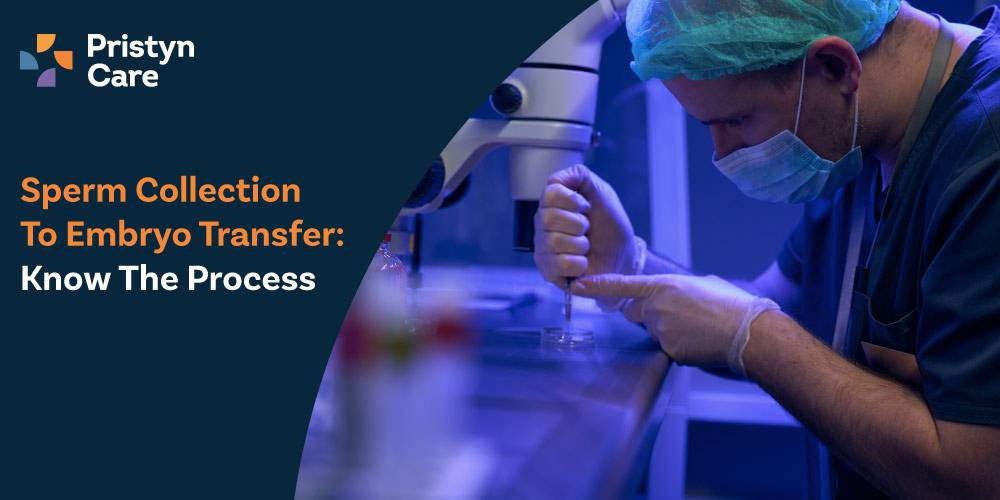
You may have seen a close one or read about someone’s IVF journey and might have been curious about what all happens behind the scenes. It often seems complex, but the process from sperm collection to embryo transfer involves a series of steps. Here, you will learn more in detail about the IVF full process for the male partner.
Table of Contents
How to collect sperm for IVF?
The most common method of sperm collection for IVF is through masturbation at the fertility clinic. You get a sterile container for collecting the fresh semen sample. It’s important to practice sexual abstinence for 2-5 days before semen sample collection. If you’re unable to collect a sperm sample at the clinic, some fertility clinics also offer the service of sperm collection at home. The condition is to keep it warm and deliver it to the lab within an hour. Fast delivery is necessary to make sure that the sperm is active and healthy.
What if the sperm count is zero?
If the sperm is absent and your attempt at semen collection fails, it’s a bit of a challenging situation. However, it doesn’t mean that there is no hope for parenthood.
These are the further steps:
- Diagnosis: Your fertility specialist finds out whether it’s obstructive (because of a blockage) or non-obstructive (because of low sperm production).
- Surgical options of the sperm collection process for IVF such as TESA, PESA, or Micro-TESE, help extract sperm directly from the testicle or epididymis in such cases.
- Donor sperm: If no sperm is found even after minor surgical procedures, doctors offer the option of a donor from a sperm bank. A lot of couples say yes to proceeding with using donor sperm to conceive successfully.
Alternate techniques of sperm collection
Not every male can provide a sperm sample by masturbation. In these cases, fertility specialists may resort to alternate techniques to retrieve sperm directly from the reproductive system.
- TESA (Testicular Sperm Aspiration)
TESA is a minor surgical procedure wherein the doctor uses a thin needle to take sperm directly from the testicle. For TESA, the doctor gives anesthesia to the patient so that they don’t experience any pain during the procedure. The needle gently extracts some testicular tissues, which are further processed in the lab for sperm extraction. Fertility specialists recommend TESA to males with azoospermia, i.e. there is no sperm in the semen or if they are unable to ejaculate.
- PESA (Percutaneous Sperm Aspiration)
PESA is yet another minimally invasive technique. In this procedure, the doctor inserts a needle into the epididymis, through the skin. Epididymis is a tube where sperm maturation takes place. It’s a quick procedure that doctors perform after giving anesthesia to the patient. It is an effective procedure for cases where there’s a blockage that prevents sperm from reaching the semen.
- Micro TESA
Micro TESA is a more advanced version of TESA with higher precision. It’s done with the help of a surgical microscope to spot fine areas in the testicles where sperm can be present. This technique is especially useful in severe male factor infertility cases, where sperm production is way too low.
Managing the sperm
After sperm collection, it passes through a series of lab procedures that make it ready for fertilization. This is what happens:
- Sperm washing: Embryologists process the sperm sample to remove seminal, debris, non-viable sperm, etc.
- Best sperm selection: Special techniques such as density gradient separation or swim-up methods help embryologists to select the strongest swimmers.
- Fertilization preparation: In traditional IVF, embryologists mix sperm with the eggs in the lab. In male factor infertility cases, doctors may directly inject sperm into the egg employing a process known as ICSI (intracytoplasmic Sperm Injection)
Making the embryos- fertilization step
Once sperm is ready, the focus shifts to the eggs. This is how further the process unravels:
- Stimulation of the ovaries: The female partner takes fertility medications to give an extra boost to the ovaries for multiple egg production.
- Retrieving egg: When eggs mature, the doctor collects them through a minor procedure known as egg retrieval process in IVF.
- Fertilization process: Eggs and sperm meet in the lab. In some cases, traditional IVF is used, where the sperm naturally fertilizes the egg. In others, ICSI is performed to boost the chances of success.
- Development of the embryo: Embryologists and doctors closely monitor the fertilized eggs (now embryos) in a special incubator. Within 3-5 days, the embryo reaches the blastocyst stage, the best time for transfer.
Embryo Transfer (ET)
Once the formation is proper and viable for the transfer, doctors choose the best-quality embryo for the transfer. On the basis of your situation, doctors advise them for either fresh embryo transfer or plan for a frozen embryo transfer process. The second approach gives more time to the body to be more receptive for embryo implantation.
It involves the following things:
- Embryo transfer procedure: With the help of a thin catheter, the doctor gently places it through the cervix into the uterus to release the embryo. It is a simple and quick procedure and takes only a few minutes to complete.
- What to expect: There is no need for the anesthesia and you can head back home after 30-60 minutes. Most women report it to feel quite similar to a pap smear test that is followed by mild cramping.
- Post embryo transfer: Doctors usually advise you to rest for a short while and gradually resume your normal routine activities. A blood test after 10-14 days confirms embryo implantation.
The emotional aspect of the IVF full process
While the medical steps are laid out, going through IVF treatment can feel emotionally intensive or complex to deal with all on your own. So, connect with support groups, talk to your partner, and feel safe to be vulnerable with your loved ones to make this journey much easier for you.
Progressing from sperm collection to embryo transfer, IVF treatment is a precisely planned process by IVF specialists. Whether sperm collection happens through natural ejaculation or a surgical technique, advanced fertility treatments allow many couples a new opportunity to conceive.
If you want to try IVF treatment, ask your fertility team regarding the best-suited option for you. Eventually, the IVF process experience of every couple is unique and there is no fixed approach that works for all. Book your consultation today to consult top IVF specialists at Pristyn Care Ferticity. We have a team of highly skilled and experienced fertility specialists who have a glorious combined experience of more than 43 years.







